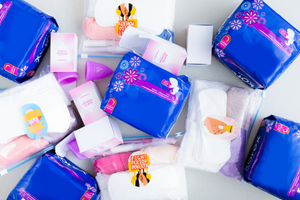
Periods are expensive, but they do not have to be. Women who cannot afford period products should have free access to them; period products are a necessity, not a desire. Periods are not a privilege, and periods are not a luxury. Until recently, I was unaware of the prohibitive implications of the cost of period products because I was never worried about where my next tampon was coming from. I did not know how many women struggle to afford period products, but I know now.
To put it on a local scale, approximately 18,083 women live in Farmers Branch. How many of these women have struggled with period poverty at some point in their life? Has your neighbor had to use an old rag as a pad because they did not have access to clean period products? Or make a choice between bread and eggs or bread and tampons? Unfortunately, period products aren’t taxed as bread and eggs, “normal” items. These fundamental items are taxed as “luxury” items, so they have an additional tax on them as if women would choose to free bleed over their schools, cars, workplaces, furniture, etc., rather than wear a tampon or pad. Periods affect every woman, regardless of socio-economic status, but when period products are not accessible, and women are expected to pay taxes on these items that are a necessity, it can be difficult to speak up and demand change; it is not like other items that can be boycotted. Boycotting cereal? Easy. We switch to oatmeal or breakfast bars. Boycotting period products to force removal of a luxury tax? Impossible. These are needed products. So, here we are, stuck in the cycle.
Let’s break down how we got here: The Pink Tax. You’re walking down the razor aisle, and men’s three-blade moisture strip razors are $5, and then, quick pause, women’s three-blade moisture strip blade razors are $8 for the exact same product. What the heck is that about? That pink razor is more expensive simply because it is pink and will be used by a woman. Manufacturers claim that there is a higher cost and market for women’s products and use this as a justification for the pink tax. This makes it easy for female consumers to buy products because living without them is close to impossible. That makes sense, right? You would purchase internet access at almost any cost because it is difficult to live without. Notice the word difficult. Internet access is difficult to live without but period products are nearly impossible to live without. The pink tax does not stop at razors; it bleeds into tampons and pads as well. Next time you make your Target run, compare prices and see the Pink Tax in action. While you’re at it, grab a box of period products to donate to Metrocrest if you are so inclined.
To gain an understanding of how the cost of period products can get to be so expensive, I looked at the community I am involved in every day. I attend an all-girls high school in the Dallas Fort Worth area, Ursuline Academy. I calculated a conservative estimate of what period products would cost for the entire student body of about 860 students. With the average woman spending $9.00 per period on period products, the student body at Ursuline spends $7,740 per month on pads and tampons alone. If that number is not staggering enough, now it is time to add the tax. In Texas, calculating the tax would add on an additional $638.55 for the student body, bringing this total in one month for Ursuline students to $8,378.55 on just tampons and pads or $100,542.60 in one year. If you assume that all 860 students have their period freshman year, over the course of their time in high school, these 860 students will pay a cumulative total of $402,170.40 inclusive of tax for period products. For the cost of four years’ worth of period products, a total of $30,650.40 is solely tax dollars. While this number includes the entire student body, it is easy to see how much this tax adds up on top of the already expensive period products.
Instead of analyzing 860 women, let’s try one. The average person who menstruates spends about $4,320 on period products in their lifetime. This assumes that a woman menstruates for approximately 40 years of their life. Of course, this price is dependent on how heavy their flow is and differs per woman on the intensity of her cycle. How can we expect every single woman to be able to afford this when poverty is already a large problem in our country, much less in Texas? Eighteen percent of Texas’ women experience poverty. While there are many factors that lead women to end up in poverty, period products should absolutely not be another reason for women to worry about what their next meal is going to consist of or where they are going to sleep. It’s time we take period products out of the equation.
I wish I could snap my fingers and tell you that there was a simple solution to this. Change starts with you: do what you can. If you have an extra box of pads or tampons lying around the house, donate them. If you have extra cash you do not see a use for, donate it to this cause. On a much larger scale, sign petitions to get things moving on the state level. Texas Legislators are on their fourth run at trying to get a bill passed to exempt feminine hygiene products from taxes altogether. Until then, speak up, and use your voice and dollars to help women in need. There is more need than we will ever know.
TLDR: Periods are unnecessarily expensive. Luxury taxes make it even worse. Speak up, and use your dollars wisely. Donate where you can, and drop off period products at Metrocrest Services or your local community center to help women in need in your area. Period.

About the Author
Morgan Merritt is a Senior at Ursuline Academy, committed to attending Michigan State University in the Fall of 2023 to study Pre-Med. Morgan has worked with the community at Metrocrest since the 1st grade when she decided her birthday presents would do much more good in the hands of others. Now as a Senior in high school, she enjoys partnering with Metrocrest Services any chance she gets.









Very informative! Did not know I could donate feminine products, good to know.
Yes! Feminine products are one of the top items requested by pantry visitors. Glad you enjoyed the article.
Could y’all rather have a donation of $ to this worthy cause? Can you buy these items cheaper yourselves???
Katherine, thank you for asking. Yes, we are able to purchase them in bulk which, allows us to access a cheaper rate. To donate, click the link below. Please designate the fund “Food Pantry” and in the public posted comments section note that the donation is for feminine hygiene products. Thank you!